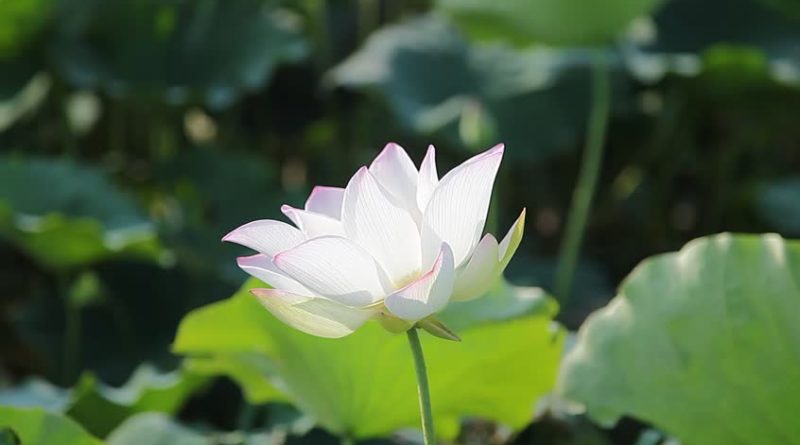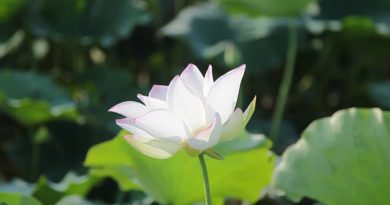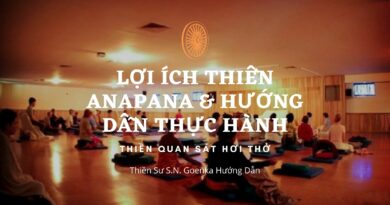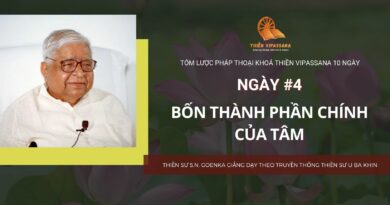Why do you give so much importance to the observation of normal respiration? – Tại sao ngài nhấn mạnh việc quan hơi thở tự nhiên?
Goenkaji: Because the Buddha wanted you to. He is very clear that one must observe the breath as it is-yathabhuta. If it is long, you are aware, “it is long”; if it is short, you are aware, “it is short”. Yathabhuta. If you make your respiration unnatural, artificial, you will give more attention to change the respiration according to your wishes. Your attention will not be with the reality as it is, but with something that you have created. Therefore, we emphasize it must be always natural breath-as it comes in naturally, as it goes out naturally. If it is long, just be aware that it is long. Don’t try to make it short. If it is short, just be aware that it is short. Don’t try to make it long. If it is going through the right nostril, then observe that it is going through the right nostril. If it is going through the left nostril, then observe it through the left nostril. When it passes through both the nostrils, observe the flow through both the nostrils. Then you are working according to the instructions of the Enlightened One. Don’t try to interfere with the natural flow of the breath. And if you find that the mind is wandering too much and you cannot feel the natural breath, then you may take a few-only a few-intentional breaths, slightly hard breaths, so that you can bring your mind back to the observation of the breath. You have to keep in mind that your aim is to feel the natural breath. However soft it is, however subtle it is, you must be able to feel it. That is the aim.
Goenkaji: Bởi vì đó là ý của Đức Phật. Đức Phật cho rằng, bạn phải quan sát hơi thở như nó đang là-yathabhuta. Nếu hơi thở dài, bạn biết nó dài, nếu hơi thở ngắn, bạn biết nó ngắn. Yathabhuta. Nếu hơi thở của bạn không tự nhiên, bạn sẽ cố ý để thay đổi hơi thở theo mong muốn của bạn. Sự cố ý đó của bạn sẽ không phải là với thực tế như nó đang là, mà là một thứ gì đó mà bạn tự tạo ra.
Do đó, chúng tôi nhấn mạnh nó phải luôn luôn là hơi thở tự nhiên – đi vào một cách tự nhiên, đi ra một cách tự nhiên. Nếu hơi thở dài, bạn biết nó dài. Đừng cố làm chậm hơi thở. Nếu hơi thở ngắn, bạn biết nó ngắn. Đừng cố kéo dài hơi thở. Nếu hơi thở đi qua lỗ mũi bên phải, hãy quan sát rằng nó đang đi qua lỗ mũi phải. Nếu hơi thở đi qua lỗ mũi bên trái, hãy quan sát nó đi qua lỗ mũi trái. Nếu hơi thở đi qua cả hai lỗ mũi, hãy quan sát hơi thở qua cả hai lỗ mũi.
Hãy làm theo hướng dẫn của Bậc giác ngộ. Đừng cố can thiệp vào dòng chảy tự nhiên của hơi thở. Nếu bạn thấy rằng tâm trí đang lang thang quá nhiều và bạn không thể cảm nhận được hơi thở tự nhiên, thì bạn có thể lấy một vài hơi – chỉ một vài – hơi thở có chủ ý, hơi thở mạnh một chút, để bạn có thể đưa tâm trí trở lại việc quan sát hơi thở. Bạn phải ghi nhớ rằng mục đích của bạn là cảm nhận hơi thở tự nhiên. Tuy hơi thở rất nhẹ, tuy hơi thở rất tinh tế, bạn phải cảm nhận nó. Đó là mục tiêu của chúng ta.
Why do you want us to keep our attention at the entrance of the nostrils and above the upper lip while practicing Anapana? – Tại sao ngài muốn chúng tôi đưa sự chú tâm vào bên ngoài cửa mũi và trên môi trên trong khi thực hành Anapana?
Goenkaji: Because again, it is a very clear instruction given by the Enlightened One. In Patisambhidamagga, he clearly says that you must be aware of the incoming breath, the outgoing breath, and mukha-this area above the mouth. He calls it mukhanimitta. It is clearly explained in Patisambhidamagga and in Vibhanga, what is mukhanimitta: it means nasikagge, the front portion of the nose at the entrance of the nostrils. Also, the Buddha says that it must be Uttarotthassa majjhimappadese. Uttara means above; ottha is lip; and majjimappadese is the middle portion. And in the Mahasatipatthana sutta, he says, establish your awareness here, parimukham satim upatthapetva. Sati means awareness; parimukham means the area above the lips.
The Buddha is so clear in his instructions. We cannot deviate from his instructions. And as you practice, it becomes very clear why the Buddha chose this small area. This is the area over which the incoming breath and the outgoing breath must pass. The incoming and outgoing breath touches the area at the entrance of the nostrils and above the upper lip. That is why he wanted you to keep your attention here. For those with long noses, the breath is likely to touch the entrance of the nostrils. For those with short noses, it usually touches the area above the upper lip. So he chose this area-either at the entrance of the nostril, nasikagge, or the middle part of the upper lip.
The Buddha does not want us to imagine that the breath is coming in or the breath is going out, you must actually feel it. When you are attentive, you can feel its touch somewhere in this area. For a very new student, we say even if you feel the breath inside the nostrils, it is okay. But ultimately you have to be aware of the touch of the breath in this area. Why? Because for samadhi, concentration of mind, citta ekaggata [one-pointedness of the mind] is very important. For a new student, a bigger triangle including the whole area of the nose is okay. But within a day or two, the student is asked to observe a smaller area. It becomes very clear, as you keep on progressing on the path given by the Buddha, that the area of concentration must be as small as possible.
It also becomes clear that the object of concentration must be very subtle. That is why when the mind is wandering too much, you are allowed to take a few hard breaths, but after that, you must come back to the natural breath. And as your mind gets concentrated, the breath will become softer and softer, finer and finer, shorter and shorter. You won’t have to make any effort. It happens naturally. Sometimes the breath becomes so short, so fine, like a thin thread, that it feels as if immediately after coming out it makes a U-turn and enters the nostrils again. So when the area is small, the object of concentration is very subtle, and you continue without interruption, the mind becomes very sharp.
The Buddha was sabbaññu-he knew everything so clearly. There is an important nerve centre in this area. When your mind is sharp and you are aware of this area, your mind becomes so sensitive that you start feeling some sensation in this area. The purpose of Anapana, the purpose of samadhi, is to take the next step of Vipassana. Vipassana is not Vipassana if you don’t feel sensations.
Therefore, he taught us in a very systematic manner. Start on a small area with the natural breath. The breath will become subtler and subtler; the mind will become sharper and sharper. This area will become very sensitive and you will start feeling sensations. Everywhere around the world, people coming to the courses and practicing the technique given by the Enlightened One, start feeling sensations in this area on the second or third day. The Buddha taught the technique, the path, very systematically. We don’t want to deviate from what he taught.
Coming back to the first question of why we work with the natural breath-there are other techniques especially in India where one controls the breath, for example, the technique of Pranayama. One takes a deep breath and stops for some time; one exhales and stops for some time. We don’t condemn other techniques. We understand that Pranayama is good for physical health. But the Buddha wanted us to use the awareness of the natural breath to reach the next step of feeling sensations. This controlled breathing, Pranayama, is not suitable because it is artificial breath.
Buddha wanted us to observe natural breath because it takes us to the stage where we can practice Vipassana. Those who want to practice Pranayama for health reasons, let them practice it separately. Don’t connect it with Vipassana. When you practice Vipassana, natural breath is important, yathabhuta, as it is.
Goenkaji: Đó là một chỉ dẫn rất rõ ràng được đưa ra bởi Bậc giác ngộ. Trong cuốn Patisambhidamagga, ngài nói rõ ràng rằng bạn phải nhận thức được hơi thở đi vào, hơi thở đi ra và mukha – ở khu vực trên môi trên. Ngài gọi đó là mukhanimitta. Nó được giải thích rõ ràng trong Patisambhidamagga và Vibhanga, mukhanimitta là: phần phía trước cửa mũi. Ngoài ra, Đức Phật nói rằng đó phải là Uttarotthassa majjhimappadese. Uttara có nghĩa là ở trên; ottha là môi; và majjimappadese là phần giữa. Và trong bài kinh Mahasatipatthana, ngài nói, hãy đưa sự chú tâm của bạn vào đó, parimukham satim upatthapetva. Sati có nghĩa là nhận thức; parimukham có nghĩa là khu vực trên môi trên.
Đức Phật chỉ rất rõ ràng. Chúng ta không thể làm khác đi. Và khi bạn thực hành, bạn sẽ hiểu tại sao Đức Phật chọn khu vực nhỏ này. Đây là khu vực mà hơi thở đi vào đi ra. Hơi thở đi vào đi ra chạm vào khu vực cửa mũi và phía trên môi trên. Đó là lý do tại sao ngài muốn bạn giữ sự chú tâm của bạn ở đây. Đối với những người có mũi dài, hơi thở có thể chạm vào lối vào của cửa mũi. Đối với những người có mũi ngắn, nó thường chạm vào khu vực phía trên môi trên. Vì vậy, ngài đã chọn khu vực này – ở khu vực cửa mũi, chóp mũi, hoặc phần giữa của môi trên.
Đức Phật không muốn chúng ta tưởng tượng hơi thở đi vào hoặc hơi thở đi ra, bạn phải thực sự cảm nhận được nó. Khi bạn chú ý, bạn có thể cảm thấy cảm giác ở đâu đó trong khu vực này.
Đối với một thiền sinh mới, ngay cả khi bạn cảm thấy hơi thở bên trong lỗ mũi thì vẫn không sao cả. Nhưng cuối cùng bạn phải nhận thức được sự xúc chạm của hơi thở trong khu vực này. Tại sao? Bởi vì đối với samadhi, sự định tâm, citta ekaggata (giữ tâm an trụ tại một điểm) là rất quan trọng. Đối với một thiền sinh mới, thì bạn có thể quan sát khu vực tam giác lớn hơn ở xung quanh mũi. Nhưng sau một hoặc hai ngày, thiền sinh được yêu cầu quan sát một khu vực nhỏ hơn. Điều này trở nên rất rõ ràng, khi bạn tiếp tục tiến bộ trên con đường do Đức Phật chỉ dạy, khu vực tập trung phải càng nhỏ càng tốt.
Và hiển nhiên đối tượng của sự tập trung phải rất tinh tế. Đó là lý do tại sao khi tâm trí đi lang thang quá nhiều, bạn được phép hít một vài hơi thật mạnh, nhưng sau đó, bạn phải trở lại với hơi thở tự nhiên. Và khi tâm trí của bạn được tập trung, hơi thở sẽ trở nên nhẹ nhàng, mềm mại hơn, tinh tế hơn, ngắn hơn và ngắn hơn nữa. Bạn không cần phải gắng gượng ép. Điều này xảy ra một cách tự nhiên. Đôi khi hơi thở trở nên rất ngắn, rất vi tế, giống như một sợi chỉ mỏng, cảm giác như thể ngay lập tức sau khi đi ra, nó liền quay lại vào lỗ mũi một lần nữa. Vì vậy, đối với một khu vực nhỏ hơn, sẽ dẫn đến sự tập trung rất tinh tế, và nếu tiếp tục không bị gián đoạn, tâm trí trở nên rất nhạy bén.
Đức Phật là sabbaññu (Bậc Toàn Giác) – Ngài biết mọi thứ rất rõ ràng. Có một trung tâm thần kinh quan trọng tại khu vực này. Khi tâm trí của bạn sắc bén và bạn nhận thức được khu vực này, tâm trí của bạn trở nên nhạy bén đến mức bạn bắt đầu cảm thấy một số cảm giác tại khu vực này. Mục đích của Anapana (quan sát hơi thở ra vào), mục đích của Samadhi, là tạo nền tảng cho Vipassana. Vipassana không phải là Vipassana nếu bạn không cảm nhận được cảm giác.
Ngài đã dạy chúng ta một cách rất có hệ thống. Bắt đầu tại một khu vực nhỏ với hơi thở tự nhiên. Hơi thở sẽ trở nên tinh tế và tinh tế hơn; tâm trí sẽ trở nên sắc bén và sắc bén hơn. Khu vực này sẽ trở nên rất nhạy bén và bạn sẽ bắt đầu cảm thấy những cảm giác. Ở khắp mọi nơi trên thế giới, mọi người đến các khoá thiền này và thực hành kỹ thuật được đưa ra bởi Bậc giác ngộ, và họ bắt đầu cảm thấy những cảm giác ở khu vực này vào ngày thứ hai hoặc thứ ba. Đức Phật đã dạy kỹ thuật, con đường này một cách rất có hệ thống. Chúng tôi không muốn đi chệch khỏi những gì Đức Phật đã dạy.
Quay trở lại câu hỏi đầu tiên về lý do tại sao phải là với hơi thở tự nhiên – có những kỹ thuật khác đặc biệt là ở Ấn Độ nơi người ta điều khiển hơi thở, ví dụ, kỹ thuật của Pranayama. Người ta hít một hơi thật sâu và dừng lại một lúc; thở ra và dừng lại một lúc. Chúng tôi không lên án các kỹ thuật khác. Chúng tôi hiểu rằng Pranayama tốt cho sức khỏe thể chất. Nhưng Đức Phật muốn chúng ta sử dụng nhận thức về hơi thở tự nhiên để đạt được bước tiếp theo là cảm nhận cảm giác giác. Hơi thở có kiểm soát này, Pranayama, không phù hợp vì đó là hơi thở nhân tạo.
Đức Phật muốn chúng ta quan sát hơi thở tự nhiên vì nó đưa chúng ta đến giai đoạn mà chúng ta có thể thực hành Vipassana. Những người muốn thực hành Pranayama vì lý do sức khỏe, hãy để họ thực hành theo cách của họ. Đừng kết nối nó với Vipassana. Khi bạn thực hành Vipassana, hơi thở tự nhiên rất quan trọng, yathabhuta, như nó đang là.
Why should we work with respiration only? – Tại sao chúng ta chỉ nên làm việc với hơi thở?
Goenkaji: Respiration is the truth. Respiration is related to your mind and matter, and you are here to make an analytical study of mind and matter. So you start with respiration, and then go to a deeper level of mind and matter.
Goenkaji: Hơi thở là sự thật. Hơi thở có liên quan đến tâm trí và cơ thể của bạn. Bạn ở đây để thực hiện một nghiên cứu phân tích về tâm trí và cơ thể. Vì vậy, bạn bắt đầu với hơi thở, và sau đó đi đến một mức độ sâu hơn của tâm trí và cơ thể.
What is the difference between Vipassana and concentration? – Đâu là sự khác nhau giữa Vipassana và sự tập trung?
Goenkaji: Vipassana is not merely concentration. Vipassana is observation of the truth within, from moment to moment. You develop your faculty of awareness, your mindfulness. Things keep changing, but you remain aware – this is Vipassana. But if you concentrate only on one object, which may be an imaginary object, then nothing will change. When you are with this imagination, and your mind remains concentrated on it, you are not observing the truth. When you are observing the truth, it is bound to change. It keeps constantly changing, and
Goenkaji: Vipassana không chỉ đơn thuần là sự tập trung (định tâm). Vipassana là quan sát sự thật bên trong, từ khoảnh khắc này đến khoảnh khắc khác. Bạn phát triển khả năng nhận biết và ý thức (chánh niệm) của bạn. Mặc cho mọi thứ vô thường (luôn liên tục thay đổi), nhưng bạn vẫn duy trì sự nhận biết và ý thức được – đây là Vipassana. Nhưng nếu bạn chỉ tập trung vào một đối tượng, có thể là một đối tượng do bạn tưởng tượng, thì sẽ không có gì thay đổi. Khi bạn sống với sự tưởng tượng này và tâm của bạn duy trì sự tập trung vào nó, bạn đang không quan sát được sự thật. Khi bạn đang quan sát sự thật, nó nhất định phải thay đổi. Nó liên tục thay đổi và bạn vẫn duy trì được ý thức về điều đó. Đây là Vipassana.
How is equanimity related to samādhi (concentration of the mind)? – Tâm xả liên quan đến samādhi (sự định tâm) như thế nào?
Goenkaji: Samādhi can be without equanimity. With the base of craving one becomes fully concentrated. But that kind of samādhi is not right samādhi. That is with the base of impurity. But if the samadhi is with equanimity, then it gives wonderful results, because the mind is pure and concentrated, so it is powerful with purity. It cannot do anything that will harm you or harm others. But if it is powerful with impurity, it will harm others, it will harm you. So equanimity with samādhi is helpful.
Goenkaji: Samādhi không thể có nếu thiếu tâm xả. Với căn nguyên là sự ham muốn, tâm cũng có thể trở nên tập trung hoàn toàn. Nhưng loại samādhi đó không phải là samādhi đúng đắn. Vì nó đi kèm với căn nguyên của sự bất tịnh. Nhưng nếu samadhi đi kèm tâm xả, thì nó cho kết quả tuyệt vời, bởi vì khi tâm thanh tịnh và định tĩnh, sự thuần khiết trong tâm được tăng trưởng. Tâm khi đó không thể làm hại chính bạn hoặc làm hại người khác. Nhưng nếu tâm mạnh mẽ cùng với đầy những bất tịnh, nó sẽ làm hại người khác, nó cũng sẽ làm hại bạn. Vì vậy, tâm xả đi cùng với samādhi là hữu ích.
The mind remains full of thoughts and is unable to keep focused at one place – Tâm trí chứa đầy suy nghĩ và không thể tập trung ở một nơi
Goenkaji: It is an old habit of the mind to wander. Let it wander. The moment you realize that the mind has wandered, bring it back to the breath. The mind is distracted because of these innumerable thoughts. The nature of the thoughts varies from time to time, but the important thing is how soon you become aware that the mind has wandered.
Goenkaji: Tâm trí đi lang thang theo thói quen cũ. Hãy cứ để nó đi lang thang. Khoảnh khắc bạn nhận ra rằng tâm trí đã lang thang, hãy đưa nó trở lại hơi thở. Tâm trí bị phân tán vì vô vàn những suy nghĩ. Những suy nghĩ khác nhau cứ diễn ra liên tục, nhưng điều quan trọng là làm thế nào bạn sớm nhận ra rằng tâm trí đã lang thang.
You say we are meditating to sharpen the mind. How do we sharpen the mind? – Ngài nói rằng chúng ta đang thiền để luyện cho tâm trí sắc bén hơn. Vậy làm thế nào để chúng ta có được điều đó?
Goenkaji: If you are with the reality and not reacting to it, naturally the mind gets sharpened. The mind gets blunt when it reacts, more and more reaction makes the mind very gross. When you don’t react, its natural reality is very sharp, very sensitive.
Goenkaji: Nếu bạn ở với thực tại và không phản ứng, tâm bạn sẽ trở nên sắc bén một cách tự nhiên. Tâm trở nên thô thiển khi nó phản ứng, phản ứng càng nhiều tâm càng thô thiển. Khi bạn không phản ứng, tâm trở nên rất sắc sảo và rất nhạy bén.
Bài viết được sưu tầm từ VRIDhamma.org









